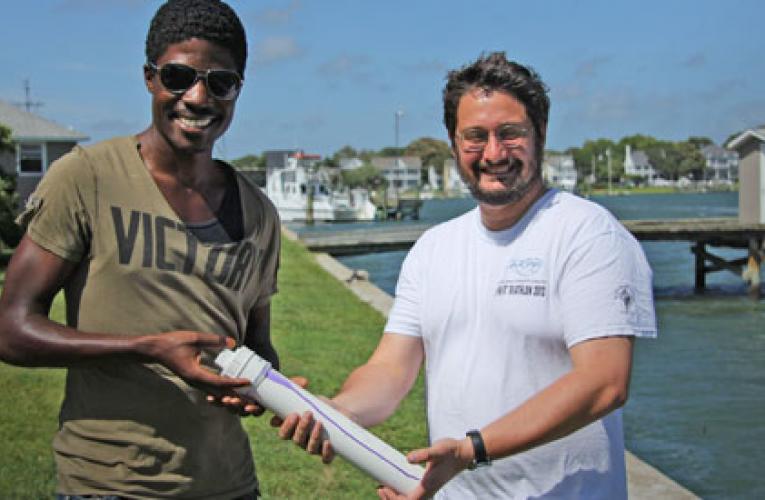Sarah G. Sunu, MEM ‘14
BEAUFORT, N.C. – Science is expensive. But a team of ‘marine cowboys’ down at the Marine Lab are working to cut some costs.
Andrew Thaler, a freelance research in Beaufort who earned his doctorate from Duke in 2012, and Kersey Sturdivant, an NSF Postdoctoral Fellow at the Duke Marine Lab, are developing an open-source conductivity, temperature and depth (CTD) sensor that can be assembled for about $200, largely from parts available at a local hardware store.
Conductivity, temperature, and depth are three of the most basic measurements in physical oceanography, Thaler explains, yet purchasing a CTD sensor commercially can pack a hefty punch to a researcher’s budget. The sensor often start at around $5000.
The idea for the OpenCTD grew out of Thaler’s urge to tinker and a discussion between him and Sturdivant about the logistics of building a CTD.
“We realized that we actually could build a functional, low-cost instrument that could potentially have a huge importance for citizen scientists, schools, and researchers who don’t have a lot of funding,” Sturdivant says.
Not only will the OpenCTD remove a financial barrier for those interested in ocean science, it will also help solve the problem of repairing CTDs on research trips, where malfunctioning equipment can cause data losses.
“I’m always thinking ‘If I was in a hardware store in Papua New Guinea, could I build this?’ I want the answer to be as close to yes as possible,” Thaler says.
Though the OpenCTD is being developed to be as accurate as professional research equipment, one of the goals of the team is to get the OpenCTD into the hands of people new to science.
“Being able to measure your own backyard ocean is a fantastic way to introduce people to scientific research. I’d love to see a network of hundreds of thousands of citizen scientists across the East Coast. It would be amazing if everyone who owns a boat had an OpenCTD, and every time they go out, they do a CTD cast,” Thaler says.
“One of the things I would love to see happen is for someone using the OpenCTD to make some measurements and discover some sort of new process in a location that would normally never get that kind of attention, and then have their initial discovery validated by more refined equipment,” Sturdivant agrees.
While the OpenCTD will ultimately be much cheaper than commercial CTDs, there are still costs associated with development. To meet those costs, Thaler and Sturdivant have turned to the internet and crowdfunding.
Crowdfunding involves private citizens investing as much, or as little, as they care to in a project via a website. By opening up the opportunity to invest to whoever’s interested, many ideas that would have difficulty being funded through conventional routes can be brought to development.
“Our core crowdfunding goal is to raise enough to develop the OpenCTD, and put together an e-book so that people will be able to build their own. And it’s been really positive, we’ve gotten a lot of responses and raised a lot more than I thought we were going to initially,” Thaler says.
Their goal is $10,000. As of early August, they’ve raised $4,305.
Any funding beyond the amount needed to develop the OpenCTD and produce the e-book will go to the building of five OpenCTDs, to be given to educators, researchers, classroom groups, or NGOs that respond to an open call for proposals and are selected by a committee.
The open-source community has been supportive throughout the development of the OpenCTD. “That’s one of the exciting aspects about this project, people who are developers and engineers are interested in how they can incorporate the final version into their own projects,” Sturdivant says.
Thaler believes that their ecology background has helped them to design a tool that meets researcher’s needs while also being technologically sound.
“A lot of developers and engineers are interested in how far they can push the technology, but because we’re practicing ecologists and oceanographers, we also have a vision for what the tool needs to do. Having groups coming at this from both ends has definitely helped us to work towards the version that’s the cheapest but that can function at a level acceptable for publication,” Thaler says.
The duo tested a working prototype, the OpenCTD Mark I – informally known as the “Flyin’ Hawaiian” – in mid-July. There are still a few kinks to be ironed out, however, so the Mark I will be decommissioned and work on the Mark II will commence shortly.
You can check out the OpenCTD’s RocketHub page at http://www.rockethub.com/projects/26388-oceanography-for-everyone-the-openctd, for updates on its progress.
